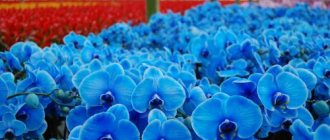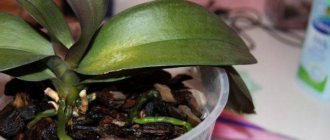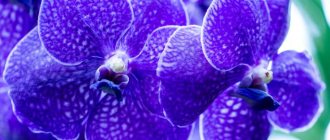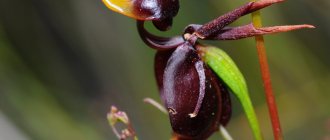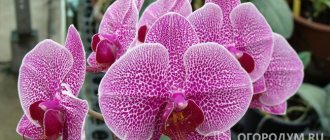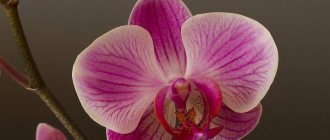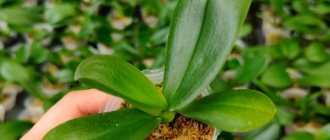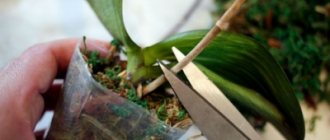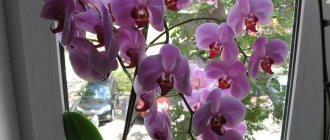The history of the blue orchid
Blue orchids were first presented in 2011, at an exhibition in Florida, by an agricultural company called Silver Vase. After 3 months, one of the participating firms demonstrated its version of the blue flower. After this event, all flower shops began to offer applications for the sale of blue or blue orchids. The Geest Orchideeën company, which was the second to show a blue flower, did not hide the fact that the color was obtained chemically and in subsequent blooms the orchids will be their natural color. The technique used by the representatives has not been disclosed to date, but experienced flower growers have found their own techniques.
Interesting! There is only one conclusion in this situation, the deep blue color of the orchid is not a feature of the variety, but only a desire to attract attention, which is achieved by coloring. In Western countries, such flowers are often used to decorate rooms for celebrations.
And phalaenopsis is white!
Just like in the fairy tale about the naked king.
These flowers really look magical, you just can’t take your eyes off them!
But for everyone who bought phalaenopsis with blue flowers, the next flowering after the store one brought flowers either white with bluish streaks (where the paint had not yet come off), or pure white.
For those less familiar with orchids, this was a big disappointment as they initially thought it was a natural blue color.
Yes, unfortunately, all the blue phalaenopsis sold in stores and even at most exhibitions are some standard varieties with white but colored flowers...
Some stores do not even hide this and write on the sign under the price tag that this is not a natural color and the orchid blooms with blue flowers only once. At least this is fair to customers.
However, not everyone is so honest. There are many sellers who pass off painted phalaenopsis as a supposedly very rare natural species and charge exorbitant prices for it. And they call it Phalaenopsis Royal Blue, which can be translated as Royal Blue Phalaenopsis.
Phalaenopsis mini and Phalaenopsis miniature - what is the difference?
But in the DNA of natural phalaenopsis there is simply no gene that produces a blue pigment. Therefore, if you are convinced that this is a species orchid, this is pure deception.
Although Phalaenopsis Royal Blue does exist, it is not a natural species, or even a hybrid. You will not find such a name in the list of officially registered hybrids. Find out what it is below...
Varieties with a blue tint
Despite the fact that deep blue orchids have not yet appeared in nature, there are still species that slightly correspond to this color scheme:
- The Vanda orchid is a variety to highlight. In nature, it can be found in the forests of China or Thailand. Vanda's purple or lilac flowers are covered with white spots. The variety is not very suitable for growing at home because it needs special care. But Vanda has the ability to cross well with other varieties of orchids, which many breeders use for their own purposes. The result is species of orchids with varying intensities of purple color.
- Cattleya is another orchid that is not as demanding of care as Vanda. During flowering, this variety has a very delicate aroma, but also does not have a rich blue or light blue color. Sometimes in stores you can find purple or pink-blue Cattleya.
- Phalaenopsis is the most unpretentious variety of orchids that can most often be found at home. In addition, this particular variety is sold in blue in stores. Phalaenopsis takes root well in homes where there are people with allergies; this plant does not have cloying odors and does not emit pollen.
Attention! All of the above species do not have the blue color we are talking about and in the most ideal version they can only have a bluish tint.
Blue miracle
There are several varieties of purple orchids that resemble blue in color, but upon close inspection they actually reveal shades of purple. Likewise, black orchids have extremely rich pigmentation that appears almost black, but it is not true black.
So what about those vibrant blue orchids you may have seen at your local flower shop? They are actually white orchids that have been artificially dyed blue. If they bloomed again, they would have white flowers. And although they look exotic and vibrant, once you find out they were painted that color, they lose much of their charm.
How can you tell if an orchid is colored?
Whether an orchid is painted or not is quite easy to understand if you pay attention to a number of signs:
- the stem of a normal orchid is of natural color, without the shades inherent in the flower;
- if a colored mark remains on the skin after touching a flower, it means that orchid paint has been applied to it;
- the soil in which the plant grows should also not show signs of coloring, its color is completely natural.
Important! If you are lucky enough to buy a blue orchid, you should know that the initial care for it is slightly different, because the plant was subject to chemical and mechanical intervention.
Tips for choosing a plant in the store
Before you go shopping for this unusual orchid, it is very important to familiarize yourself with some recommendations for choosing the right one, which, in turn, will help prolong the life and beauty of the flower. It is preferable to buy phalaenopsis at specialized exhibitions and sales. They present plants selected according to more stringent criteria than in regular stores.
Directly when choosing a flower, it is recommended:
- Pay attention to the color of the stem and leaves. If a clear blue tint is noticeable, this indicates that too much dye has been introduced into the plant.
- Examine the stem, peduncle and flowers. There should be no signs of a prick on the stem. Otherwise, the flower will soon die, since the dye should only be injected into the peduncle. Unopened flower stalk buds are a sign of long flowering in the future.
- Visually examine the root system of the plant. It must be healthy, clean, free of fungal and mold. Detected dots and spots will indicate that the plant is affected by harmful insects.
- Pay attention to the soil: it should not contain musty, putrid or chemical odors.
- Inquire about the age of the plant presented . The young flower will not bloom immediately.
Did you know? The smallest flower of the orchid species Platystele jungermannioides is only 1 mm in diameter.
How to get blue orchid flowers?
There are two ways that help give blue tones to a white flower. The most humane of them is coloring through water that is watered on the plant. This method has the disadvantage that when watering stops, the flower returns to its natural color. In addition, the stem of the orchid also becomes somewhat blue during watering. To obtain the desired effect, it is enough to dissolve the dye in water in the required concentration; the more dye, the richer the color of the flowers.
Important! It should be remembered that the use of dyes is harmful to the plant.
A blue orchid at home can be obtained after coloring injections. The injection is usually given in the area of the peduncle; it should be carried out as least traumatically as possible. You need to take a syringe with the thinnest needle and fill it with liquid with dye.
For mixing, it is better to take warm, settled water, and the injection site and the needle itself must be disinfected. If there is no opportunity or desire to buy chemical coloring preparations that are available in flower shops, you can use food coloring.
Important! It is better to carry out coloring injections by piercing the peduncle; introducing the drug into the roots is the most traumatic for the orchid.
It is necessary to understand that any of the methods is potentially dangerous for the orchid and can lead to diseases and even death of the plant. After applying the coloring material, the flower needs additional care.
Flower in the house: care features
The problem lies in the fact that some unscrupulous sellers, wanting to make extra money, take on the coloring themselves. They present the result of their work as Phalaenopsis Royal Blue and sell it at a price three times higher than ordinary white flowers.
Naturally, we are not talking about any technology here. Coloring is sometimes done using simply barbaric methods . The dye, often ink, is injected into the peduncle, stem, or root. This procedure greatly weakens the plant, being a source of stress for it. Poisoned by harmful substances, the flower may simply die.
When you buy or receive a blue plant as a gift, inspect it carefully. If the injection mark is visible on the peduncle, then the plant has a greater chance of survival. If the injection was made into the root, then there is a high probability of death.
Sometimes phalaenopsis is colored by watering it with colored water, in which case a blue tint can be observed not only on the flowers, but also on the leaves and roots. Whether the plant survives or not depends on the degree of damage caused to it.
Did the orchid produce buds that were not blue, but white? There is no need to try to paint it yourself, pour blue or ink on it. This can cause the plant to get sick and die . It’s better to enjoy her natural, no less beautiful outfit.
Do not rush to replant a painted plant immediately after purchase - it may not withstand another stress. Otherwise, the care requirements are the same as for ordinary orchids, but you need to carefully monitor its condition.
If after purchase the flower begins to lose buds, it means that it has not coped with the negative influence of the dye. In this case, it is necessary to take urgent measures to save him . To do this you should:
- cut off the peduncle, which contains harmful dyes;
- rinse the roots with warm water, carefully examine them and cut off rotten and blue areas;
- sprinkle the sections with ash and dry well;
- clean the pot from old soil and fill it with new soil, specially designed for orchids;
- plant the flower in new soil.
It is strictly not recommended to use old substrate in which the “sick” plant was located.
Further actions
If you bought a painted orchid at a flower shop, you should not rush to replant it. Depending on how long ago the procedure was carried out, the flower needs a period of rest and the opportunity to adapt to new conditions.
If you notice a deterioration in the condition of the orchid after purchase, you need to take some measures:
- Carefully remove the plant from the pot and rinse the roots under running water.
- Trying to find traces of injections, if they are found in the root area, it will be difficult to save the orchid.
- Usually the place where the injection was made forms rot; it is advisable to cut off this place and apply crushed coal or ash.
- After inspection, transplant the orchid into new soil, which consists of moss and bark.
- In the future, if the orchid begins to recover, care for it is standard, intended for the variety.
Lighting
Lighting conditions are very important for any type of orchid. If the pot with the plant is placed on the west side, you can practically eliminate the need for artificial lighting.
The western side of the window prevents direct sunlight from entering the flower.
It is also possible to place an orchid on the south side of the apartment all year round, but on hot days it is necessary to control the soil moisture and add water if necessary. The location of the orchid pot on the windowsill on the north side requires the installation of additional phyto lamps, which will extend the daylight hours.
The orchid blooms best if it is illuminated for 12-16 hours.
Interesting! If there are no purple pigment spots on the inside of the leaf, this indicates that the orchid does not have enough lighting.
Despite its light-loving nature, the sun can be dangerous for orchids during its active period; at this time it is better to hide the plant in the shade. If it is not possible to extend the daylight hours for an orchid, cut it off for the winter and leave it until the lighting increases naturally.
Conditions of detention
Orchids must be kept in special conditions.
Lighting
The gardener should attach special importance to this criterion, since the development and viability of any orchid depends on it. To determine the plant’s need for light, you need to study the natural conditions of the species. In winter and summer, it is recommended to place the plant on the western side; in this case, the owner of the flower frees himself from the obligation to provide additional lighting. In addition, with this arrangement the flower will avoid direct exposure to dangerous ultraviolet rays.
Another option for winter maintenance is the south side, at this time the sun's rays are not able to burn the plant. If the crop is located in the southern part throughout the year, then it is necessary to regularly monitor the degree of drying of the soil and adjust the watering regime. The least preferred location for the blue variety is the north side, however, if there is artificial lighting, such as a phytolamp, this location will not be a problem.
According to experienced flower growers, optimal daylight hours ensure the most frequent flowering. If there is not enough lighting, the plant directs all its energy to the development of leaves. Light deficiency can be determined by the light shade of the foliage, and its inner side in this case does not have purple pigmentation. The duration of daylight for this crop is 12-16 hours, for fragile or unhealthy specimens - up to 18 hours a day.
Too intense light is also dangerous. The sun's rays can cause burns on the leaves of this fragile flower, so the plant should not be left in direct rays. It is necessary to maintain daylight hours in winter if the owner wants to admire the lush blooms. If this is not necessary, then you can leave the flower until the daylight hours begin to increase in accordance with the season.
Temperature
If you grow phalaenopsis, you should know that this is a heat-loving species, and therefore even the night temperature should not be lower than +18 degrees. Daytime limits are 25.30 degrees above zero.
Failure to comply with the temperature regime threatens serious diseases or the risk of the plant being attacked by pests. Both low and too high temperatures lead to such consequences.
In order for a flower to actively grow and develop, it is necessary to observe daily temperature fluctuations, which should correspond to 8-10 degrees. And also when setting the regime, it is important to pay attention to the phase of the plant’s life cycle. You can adjust the temperature based on the condition of the flower itself. For example, during the dormant period the room should be cooler than during the active growing season.
Watering and fertilizing
The watering regime should be adjusted independently, based on the ambient temperature; the faster the moisture evaporates from the pot, the more often it is necessary to add water. In any situation, the humidity level must not be exceeded, as this can cause rotting of the root system.
For many gardeners, the immersion method is convenient, in which the pot along with the plant is lowered into a container filled with water for 30-60 minutes. After the pot is cured, excess moisture is drained through the drainage holes.
If you use watering in the form of bathing the orchid, you need to do this under a weak water set or use a shower. Then let the water drain and remove moisture from the axils of the leaves.
Due to the unusually bright colors, it becomes clear why the blue orchid is so popular. Before you decide to carry out the coloring procedure at home, you should understand that interfering with the natural course of an orchid’s life can be detrimental to its health.
